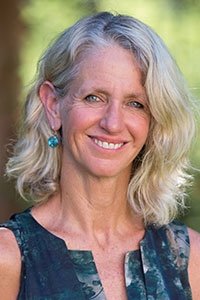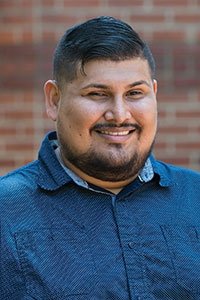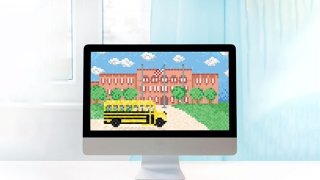This April, The New York Times requested comments from students age 13 and older on a story about the controversies that ensued when two Kansas high schools rolled out a web-based curriculum by Summit Learning, a Silicon Valley (and Facebook-backed) platform. While many commenters raised concerns about this more personalized, tech-rooted approach to education, others saw much potential.
“Everyone has the right to receive a proper and beneficial education. With that being said, the way you receive it should be your choice,” wrote Sloane F., a high school student in Wilmington, N.C. “I believe online learning can be beneficial, but only if it works for you.”
And it can—according to educators working at cyber high, middle and elementary schools—for students with a variety of needs.
“I knew a student with severe anxiety, to the point she just wasn’t going to school,” says Doug Bourget MAT ’14, former principal of Maine Connections Academy, a cyber charter school serving students in grades 7–12. “She needed to be at this little spot by her radiator where she felt comfortable. Bringing the classroom to her was a game-changer.”
Through online tools created to mirror real-life interactions, along with therapy and other support, the student gradually grew less anxious and eventually was able to see people face to face.
“It changed her life,” says Bourget. “Twenty years ago, she maybe would have just dropped out.”
Logging On to Learn
Students and their families choose to pursue a more tech-based education over the traditional classroom for many reasons. Perhaps a student is an elite-level athlete in training or a working actor; perhaps the student has a health issue or has faced bullying. Sometimes, too, students just perform better in an online environment and prefer it.
“Some people think struggling through school is unavoidable, but there are different schooling options where kids can thrive,” says Dustin O’Malley EdD ’12, principal of Tustin Connect, an online K–12 school for students in Orange County, Calif. “So many of our students’ parents tell us they wish they’d had this option when they were in school.”

Founded five years ago, Tustin Connect offers its 200 full-time students a “blended” learning environment, allowing for routine face-to-face time with teachers and classmates at the school’s campus.
“Kids have their own personalized assignments, along with the opportunity to work with teachers and peers in groups,” O’Malley explains. “Students really enjoy the social interaction with their peers and the chance to work one-on-one with their teachers.”
His interest in online education stemmed from his own experiences as a student.
“I found myself often uninterested or restricted in a traditional educational setting,” O’Malley says. “Many students just need something more personalized.”
Newer technology has made this personalization and flexibility in curriculum more possible.
“Independent study has been around for years, but it has traditionally been mostly textbook- and packet-based,” O’Malley says. “Teachers now have access to great tools to really gauge student learning, and the opportunity for immediate feedback is huge in terms of learning and motivation.”
This high-tech approach, where students develop real-world skills and have the ability to work and learn both remotely and on site, has another positive effect.
“Overall, I think technology makes the connection between school and work a little bit clearer,” Bourget says. “An office can have a meeting where employees attend virtually from around the world; at an online school, teachers can have a presentation and students from all over can raise their hands and ask questions using things like microphones and cameras.”
Bourget experienced this firsthand as a USC Rossier student.
“I was teaching in South Korea while taking classes at USC with people spread out across the U.S. and around the world,” he says. “In spite of location, you could hold a class and have small-group discussions at one time. It was cool to be able to do that.”
High-Tech Obstacles
From Wi-Fi connection troubles to students sneaking on social media, incorporating technology into the classroom isn’t without challenges—and it isn’t for everyone.
“Some kids assume online learning is easier, and it’s not,” says O’Malley. “Doing any kind of online or blended learning requires a lot of self-discipline, accountability and organization; some students struggle with that.”

Additionally, technology can lead to more isolation.
“Our blended environment helps solve this problem,” O’Malley says. “But some students can still feel withdrawn and would be better suited in a more structured traditional classroom.”
Another challenge that comes with technology is how it’s packaged and sold to educators.
“You can’t just give someone a program or a tool and they’re going to learn—it’s really easy to waste your money buying technology and not implementing it well,” Bourget says. “You have to really think about how you’re going to budget the time and resources to execute it successfully.”
An Overall Evolution
Technology continues to transform the role of educators, often making teaching simultaneously more gratifying and complex.
“With so much access to information at every student’s fingertips, teachers aren’t really the holders of knowledge in the way it seemed in the past,” O’Malley says. “I don’t see that as a negative—good teaching starts with having a connection with your student, whether it’s in person or over email or a video chat. There’s power in a student feeling they’re cared about.”

Teachers have also become instrumental in showing students how to use technology responsibly, especially with an increased dependence on smartphones becoming a universal trend across generations.
“With all this technology in our pockets, it’s very easy for anyone—teacher or student—to engage in inappropriate behavior or even just get distracted,” Bourget says. “I think it’s invaluable for all of us to learn and model how and when to use technology.”
O’Malley also looks forward to seeing how technology will enhance and improve education in the future at Tustin Connect and across the board.
“Educational technology has plenty of room for further innovation and improvement, but I think we’re going in the right direction,” he says. “Artificial intelligence has so much potential—imagine a brilliant, personalized virtual tutor that can assess a student’s precise academic level, and then dynamically adapt the curriculum to optimize and accelerate learning. I think that’s where we’re going, and it’s thrilling.”
Technology also has the capacity to break down barriers and give more students access to education, including unique schedules that allow students to work or care for family members during the day.
“In addition to personalizing the curriculum itself, if we keep an open mind, we can really personalize to the needs of the community,” says Bourget. “The No. 1 thing is to empower people who don’t have great access to education. It’s exactly what the USC Rossier mission says: to achieve educational equity for all.”
Keeping Ed Tech in Perspective
A Q&A with Patricia Burch, USC Rossier associate professor

WHAT IS THE STATE OF ED TECH?
The advantages are many. As I and others have argued through empirical research, realizing these advantages turns on classroom teachers, on strong curriculum and the capacity for powerful instruction.
WHAT SHOULD WE BE AWARE OF?
The deeper social isolation technology may be engendering for students and for us all. As tech connects, it also creates a reason for us to eschew meaningful interaction. We also run the risk of replacing the principles of democratic schooling with a kind of “technocentrism”—a blind faith in the inherent good of technology without careful reflection about things such as the privacy and rights it can endanger, the jobs that might be displaced, the institutionalized racism it might be reproducing.
WHY SHOULD WE MAINTAIN A HEALTHY SKEPTICISM ABOUT TECH?
Technology has long been marketed as doing absolutely everything, but it’s important to challenge false or unsupported claims because money spent on technology is money not spent on something else, possibly a phenomenal classroom teacher. In fact, a recent study suggests much of the tech purchased for classrooms ultimately goes unused.
BEFORE BUYING NEW TECH, WHAT SHOULD SCHOOLS ASK THEMSELVES?
Where does the tech already purchased stand now? Too often, economic privilege becomes a gateway to better tech, better bandwidth and technological capital. Like other forms of capital (social, human, financial), tech capital doesn’t necessarily disrupt inequalities. It may reproduce them.
WHAT ARE VENDORS’ RESPONSIBILITIES?
A significant responsibility for accountability to the democratic purposes of schools. It’s not acceptable to have teachers bear the burden of differentiating or supplementing curriculum so that it meets the needs of racially, culturally and linguistically diverse classrooms. Businesses must also play a role in redistributing resources so that tech addresses rather than reproduces opportunity gaps.
WHAT OTHER QUESTIONS EXIST?
Who decides what tech will be bought? Who owns the data? What processes are in place to ensure that those who historically have been disadvantaged by schools have access to the best tech? I hope that USC Rossier will lead the search for the answers.
MORE IN HER OWN WORDS ► rsoe.in/BurchQA and rsoe.in/BurchPDK
My Tech-Enabled Education
I’m proof of how students and teachers with special needs benefit from technology
by Jorge Camacho MAT ’20
I am pursuing my secondary math teacher credentials via USC Rossier online. I love anime, chess and teaching myself how to play the piano. On a side note, I am also legally blind and deaf, and technology has been a big help for me on my journey.

I have Usher’s syndrome, which affects both hearing and vision. Growing up, no one knew that I had these issues—my doctors thought I was mentally disabled. I was transferred back and forth from mainstream to special-needs schools. It wasn’t until I was 8 years old that one special-needs teacher realized I couldn’t communicate the way other kids did because I was hearing impaired. I could not hear clearly; therefore, I could not communicate clearly.
When I got a hearing aid, my oral communication improved drastically, but it was challenging since I then had to learn to communicate at home in Spanish and at school in English. I had also been so isolated, communication-wise, that I didn’t know what many basic words even were, like “music” or “video games” or “college.”
At 19, I was diagnosed with retinitis pigmentosa, a genetic disorder that involves the breakdown and loss of cells in the retina. I didn’t think much of it until I was a college student at UC Santa Cruz and the reality kicked in. My vision worsened, and I kept bumping into people and things and falling over. I was afraid to leave my room and became really depressed.
Even so, I always had a gift for math, and I had some wonderful teachers who went the extra mile to meet me where I was. I decided I wanted to be a math teacher myself and to construct a better pedagogy for students who face challenges and disabilities the way I have.
As an online USC Rossier student, I know firsthand what a challenge any classroom can be. Even with a hearing aid, I sometimes find it difficult to hear if a classmate asks a question, so I make use of closed captioning. California’s Department of Rehabilitation was able to provide me with several devices, including a voice recorder with a camera that will transmit the video into a tablet or computer so I can zoom in on any text the professors write.
Technology has been so helpful, but there are issues, too—connectivity problems, or dead batteries, or the size of the frames I have to look at to read. I’m also colorblind, and my screen filters out blue light, so there was a moment when I missed instructions that appeared in certain colored popup boxes.
My life, thus far, has been challenging, and I know it will continue to be challenging, but I’m excited by my accomplishments. In my own teaching career, I’ll be using technology—some of which doesn’t even exist yet—to create lessons that best fit my students and to construct a room environment where they feel safe and empowered to be and do their best. Hopefully, by sharing my identity, my struggles and my successes, it will demonstrate to my students that limitations do not necessarily lead to failure.




